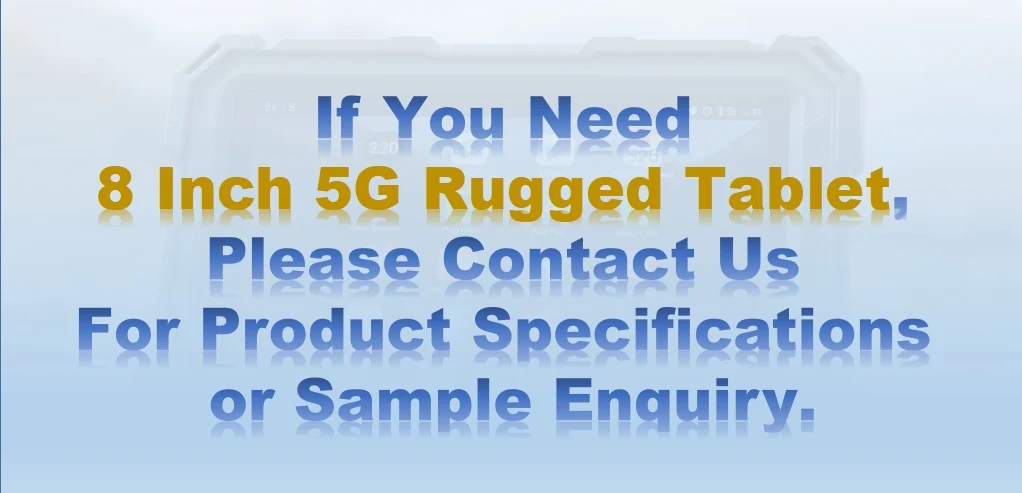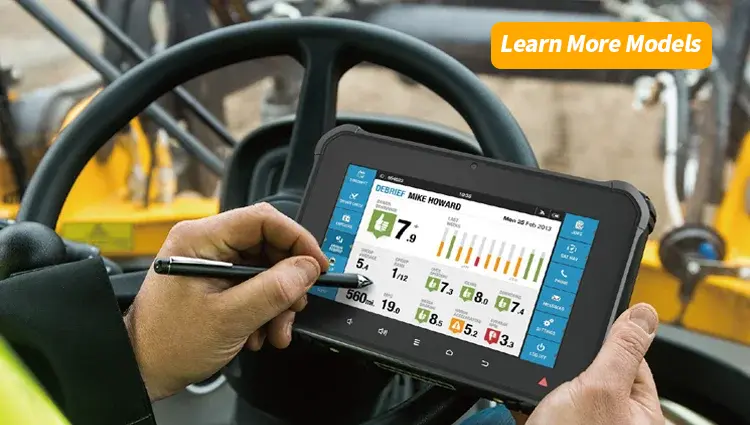How to Choose the Best 5G Rugged Tablet for Your Needs
Abstract
The advent of 5G technology has revolutionized mobile connectivity, offering unprecedented speeds and ultra-low latency. When combined with the robust design of rugged tablets, this creates a powerful tool for professionals operating in demanding environments. This article serves as a comprehensive guide for choosing the best 5G rugged tablet tailored to specific industry needs. We will delve into critical factors such as durability standards (MIL-STD-810H, IP ratings), performance specifications, connectivity options, display characteristics, and ergonomic considerations. Through a detailed analysis and exploration of real-world application cases, we aim to provide actionable insights that enable businesses and individuals to make informed purchasing decisions, ensuring optimal performance and longevity in challenging work conditions.

Introduction
In today’s fast-paced and increasingly connected world, traditional office environments are rapidly expanding into the field, factories, and even hazardous zones. For professionals working in these challenging settings, standard consumer-grade tablets simply won’t suffice. This is where 5G rugged tablets come into play. These devices combine the blazing-fast speeds and low latency of 5G connectivity with a durable design capable of withstanding drops, spills, extreme temperatures, and vibrations.
Choosing the right 5G rugged tablet is a critical decision that directly impacts productivity, efficiency, and data integrity in various industries, from logistics and manufacturing to public safety and utilities. This guide will walk you through the essential considerations to ensure you select a tablet that not only meets your current operational demands but is also future-proofed with cutting-edge 5G capabilities.
What Makes a Tablet “Rugged” and Why 5G Matters
Before diving into selection criteria, it’s crucial to understand what defines a rugged tablet and why 5G connectivity is a game-changer for these devices.
Defining “Rugged”
A rugged tablet is engineered to perform reliably in harsh conditions where consumer devices would fail. Its durability is typically measured by:
- MIL-STD-810H Certification: This is a series of tests developed by the U.S. military to simulate various environmental conditions, including drops (often from 4-6 feet), shocks, vibrations, extreme temperatures, humidity, altitude, and more. A tablet with this certification has proven its resilience.
- IP (Ingress Protection) Rating: This two-digit code indicates a device’s resistance to dust and water. The first digit (0-6) relates to dust protection, and the second (0-9K) relates to water protection. For instance, an IP65 rating means the device is dust-tight and can withstand low-pressure water jets, while IP67 means it can be submerged in up to 1 meter of water for 30 minutes. Higher numbers indicate greater protection.
- Drop Protection: Often specified as a drop height onto concrete.
- Operating Temperature Range: The range of temperatures (e.g., -20°C to 60°C) at which the tablet can safely operate.
The 5G Advantage for Rugged Tablets
5G connectivity brings significant benefits to rugged applications:
- Blazing-Fast Speeds: Download and upload speeds that are exponentially faster than 4G, enabling quick transfer of large files, high-resolution images, and real-time video feeds.
- Ultra-Low Latency: Minimal delay in data transmission, crucial for real-time control of machinery, augmented reality (AR) applications, and instant communication in critical scenarios.
- Higher Bandwidth: Supports more devices and concurrent data streams, ideal for crowded industrial environments or large-scale data collection.
- Enhanced Reliability: More stable and consistent connections, reducing dropped signals in challenging areas.

Key Factors to Consider When Choosing a 5G Rugged Tablet
Selecting the ideal 5G rugged tablet requires a holistic evaluation of several interdependent factors.
1. Durability and Environmental Ratings
This is often the primary concern for rugged devices.
- Identify Your Environment: Assess the specific hazards your tablet will face: Are there frequent drops? Is it exposed to dust, water, extreme heat or cold, or corrosive substances?
- MIL-STD-810H Compliance: Look for tablets certified to the latest MIL-STD-810H standard for comprehensive ruggedness. Understand which specific tests are crucial for your use case (e.g., drop, vibration, temperature shock).
- IP Rating: Match the IP rating to your exposure to dust and water. For outdoor use or environments with liquid exposure, aim for IP65 or higher (e.g., IP67, IP68).
- Material Construction: Examine the materials used (e.g., reinforced chassis, Gorilla Glass or equivalent for the screen, sealed ports).
2. Performance and Processing Power
The internal components dictate how smoothly your applications run.
- Processor (CPU): Choose a processor that can handle your typical workload. Intel Core i5/i7 (for Windows) or higher-end Qualcomm Snapdragon/MediaTek (for Android) are common in high-performance rugged tablets.
- RAM (Memory): 8GB to 16GB is often a good starting point for multi-tasking and demanding applications.
- Storage (SSD): Solid-state drives (SSDs) are essential for ruggedness (no moving parts) and speed. Choose sufficient capacity (e.g., 128GB, 256GB, 512GB) for your data and applications.
- Operating System (OS):
- Windows: Offers full compatibility with enterprise software, strong security, and familiar desktop experience. Ideal for complex tasks and integration into existing IT infrastructure.
- Android: More user-friendly interface, vast app ecosystem, and often lower cost. Popular for simple data collection, field service, and specific vertical applications.
- Linux: Niche use, typically for highly specialized industrial control or custom applications.
3. Display Characteristics
The screen is your primary interface with the device.
- Size: Common sizes range from 8 inches to 12 inches. Consider portability versus screen real estate for viewing schematics or large datasets.
- Brightness (Nits): Crucial for outdoor visibility. Look for at least 500 nits, with 800-1000+ nits being ideal for direct sunlight.
- Resolution: Higher resolution (e.g., Full HD 1920×1080) provides sharper images and more screen space.
- Touchscreen Type:
- Capacitive: Standard multi-touch, glove-compatible options available.
- Digitizer/Pen Support: Essential for precise input, signatures, or drawing.
- Wet-Touch/Rain Mode: Allows operation even when the screen is wet.
- Glove and Rain Mode: Ensure the touchscreen remains responsive when wearing work gloves or in wet conditions.
4. Connectivity Options
Beyond 5G, other connections are vital.
- 5G Band Support: Verify the tablet supports the specific 5G bands used by your chosen carrier(s) (Sub-6 GHz, mmWave if ultra-high speeds/densities are needed).
- Wi-Fi: Wi-Fi 6 (802.11ax) or Wi-Fi 6E for faster, more reliable local network connections.
- Bluetooth: Latest versions (e.g., Bluetooth 5.2) for connecting peripherals like barcode scanners, headsets, or external sensors.
- GPS/GNSS: High-precision GPS/GNSS for accurate location tracking in navigation, asset management, and mapping applications.
- Ports: USB-C (for charging and data), full-size USB-A, HDMI, Ethernet (RJ45), serial ports (RS232/RS485) for legacy equipment. Assess your peripheral needs.
5. Battery Life and Power Management
Critical for all-day operation in the field.
- Battery Capacity: Measured in mAh or Wh. Higher numbers mean longer life.
- Hot-Swappable Batteries: Allows batteries to be replaced without shutting down the device, ideal for continuous operation.
- Charging Options: Fast charging, vehicle docks, multi-bay chargers.
6. Ergonomics and Portability
How the tablet feels and is carried matters for user comfort and productivity.
- Weight and Dimensions: Balance screen size with ease of carrying. Lighter tablets are better for mobile workers.
- Accessories: Hand straps, shoulder straps, vehicle docks, keyboard attachments, carrying cases.
- Buttons: Programmable buttons can offer quick access to frequently used functions.
7. Integrated Peripherals and Expansion Options
Many rugged tablets come with built-in tools.
- Barcode Scanner: Integrated 1D/2D barcode scanners significantly speed up inventory management and asset tracking.
- RFID Reader: For tracking inventory or personnel with RFID tags.
- Cameras: Front and rear cameras for documentation, video calls, or augmented reality (AR) applications. Consider resolution and low-light performance.
- NFC (Near Field Communication): For quick pairing or data exchange.
- Optional Modules: Some tablets offer modular designs, allowing you to add specific features like thermal cameras, extended range RFID, or custom ports later.
8. Security and Manageability
Protecting your data and device fleet.
- Hardware-Level Security: TPM 2.0 (Trusted Platform Module), secure boot.
- Biometric Authentication: Fingerprint readers, facial recognition for secure login.
- Remote Management: Compatibility with Mobile Device Management (MDM) solutions for remote deployment, monitoring, and security updates.
- Data Encryption: Ensure full disk encryption capabilities.

Real-World Application Cases of 5G Rugged Tablets
The versatility of 5G rugged tablets makes them indispensable across a multitude of industries.
Case Study 1: Field Service Technicians (Utilities, Telecom, HVAC)
- Challenge: Technicians need immediate access to schematics, manuals, customer data, and remote diagnostic tools while working outdoors or in challenging environments. Traditional laptops are cumbersome, and consumer tablets are too fragile.
- Solution: Getac UX10 G4 (with 5G) is often chosen for its robust design (MIL-STD-810H, IP65), bright outdoor-readable display, and comprehensive connectivity (5G, Wi-Fi 6E, GPS). Technicians can download large system diagrams quickly via 5G, conduct video calls with remote experts, and update work orders in real-time.
- Outcome:
- Reduced downtime: Faster diagnostics and access to information.
- Improved first-time fix rates: Technicians have all the necessary data at their fingertips.
- Enhanced safety: Real-time communication and access to safety protocols.
- Streamlined workflows: Digital forms and immediate data sync.
Case Study 2: Public Safety and Emergency Services (Police, Fire, EMS)
- Challenge: First responders require durable devices that can withstand drops, exposure to elements, and operate in stressful, fast-paced situations, providing immediate access to critical information like suspect databases, building blueprints, and live video feeds.
- Solution: Panasonic Toughbook G2 (with 5G) is a popular choice for its extreme durability (MIL-STD-810H, IP65), bright screen for viewing in varying light conditions, and robust communication capabilities. 5G enables rapid data transfer for real-time intelligence, high-definition video streaming from bodycams, and secure communication.
- Outcome:
- Faster response times: Access to accurate information on the go.
- Enhanced situational awareness: Real-time data and video feeds.
- Improved officer safety: Better informed decision-making.
- Reliable communication: Even in congested areas or during critical incidents.
Case Study 3: Manufacturing and Warehousing
- Challenge: Managing inventory, tracking assets, quality control, and operating machinery in dusty, noisy, and often temperature-variable environments. Connectivity needs to be reliable for IoT device integration and real-time data updates.
- Solution: Zebra ET80/ET85 (with 5G) is often deployed for its modular design (convertible to a laptop), integrated barcode scanning, and ruggedness (MIL-STD-810H, IP65). 5G facilitates real-time inventory updates, seamless communication with automated guided vehicles (AGVs), and instant access to manufacturing execution systems (MES).
- Outcome:
- Increased operational efficiency: Faster data capture and inventory management.
- Reduced errors: Automated scanning and real-time data synchronization.
- Improved productivity: Workers have direct access to critical systems on the factory floor.
- Enhanced supply chain visibility: Real-time tracking of goods.
Future Outlook
The trajectory of 5G rugged tablets is towards even greater integration and intelligence. We can expect:
- Further Miniaturization and Lighter Designs: Maintaining ruggedness while reducing weight and bulk.
- Enhanced AI Capabilities: On-device AI for predictive maintenance, intelligent data processing, and augmented reality overlays.
- Edge Computing Integration: Processing data closer to the source for even lower latency and greater security.
- Advanced Sensor Integration: Built-in thermal cameras, gas detectors, and environmental sensors for specialized tasks.
- Modular and Customizable Platforms: More interchangeable modules to precisely match evolving industry needs.
Conclusion
Choosing the best 5G rugged tablet is an investment that can significantly enhance operational efficiency, worker safety, and data accuracy in demanding environments. By carefully considering durability ratings (MIL-STD-810H, IP), performance specifications, display features, comprehensive connectivity, and ergonomic design, you can select a device that not only withstands the rigors of your industry but also leverages the transformative power of 5G connectivity. The real-world case studies demonstrate that these devices are not just tools but essential components of modern, highly efficient, and resilient enterprise operations. Making an informed choice now will ensure your team is equipped for the challenges and opportunities of the future.

FAQs
1. What is the most important feature to look for in a 5G rugged tablet?
While all features are important, the most critical one depends on your specific use case. However, durability ratings (MIL-STD-810H and IP rating) are universally paramount, as they determine if the tablet can survive your working environment. Following that, 5G connectivity ensures future-proof, high-speed data access.
2. Is a higher IP rating always better?
Generally, yes, a higher IP rating indicates greater protection against dust and water ingress. However, consider your actual exposure. If your tablet will never be submerged, an IP65 or IP66 might be sufficient, and opting for IP67 or IP68 might add unnecessary cost or bulk without providing additional practical benefit for your specific needs.
3. What’s the difference between MIL-STD-810H and older versions like 810G?
MIL-STD-810H is the latest revision of the standard, featuring updated test methods and more stringent requirements in some areas compared to older versions like 810G. While both indicate ruggedness, H signifies testing against the most current military standards. Always look for the latest revision if possible.
4. Can 5G rugged tablets replace laptops in the field?
In many scenarios, yes. Modern 5G rugged tablets with powerful processors (like Intel Core i5/i7) and sufficient RAM, especially those with keyboard attachments or a convertible design, can effectively handle many tasks traditionally performed by laptops, offering greater portability and durability in challenging environments.
5. How much should I expect to pay for a good 5G rugged tablet?
The price of a 5G rugged tablet can vary significantly based on its features, brand, durability ratings, and specifications. Entry-level models might start around $1,000 – $1,500, while high-end, fully-featured tablets with advanced processors, extensive connectivity, and specific certifications can easily range from $2,500 to upwards of $5,000 or more.








